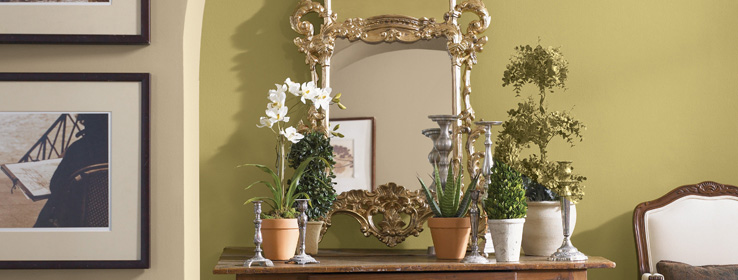Decorating with mirrors is a creative and fairly frugal way to bring style and beauty to a space.
Sometimes a fresh coat of paint isn't the only way to breathe new life into a home's interior. Mirrors can be a refreshing addition to any room. They can serve as a visual anchor, enhance wall color, increase the brightness of the room or even make it feel as though the room is larger than it really is.
Interior stylist and author Lesley Dilcock believes in the magic of mirrors: "A room without a mirror is somehow a room without a soul. Bring several of them into a room and you will immediately introduce a kaleidoscope of light and color into the space," she says.
Today's mirrors come in all sizes, shapes, styles, types and finishes and can be found nearly everywhere – from discount retailers, to flea markets and antique stores, to high-end department stores and specialty stores. It all depends on what you're looking for and what effect you want to achieve.
Pull the room together
Anchoring a room gives the pieces within it a feeling of cohesiveness. An anchor can serve a dual purpose: It creates a visually appealing focal point that highlights a specific object or objects. At the same time, it can draw attention away from some other less-than-favorable element – like a low ceiling, an out-of-date fireplace or piece of furniture, or flooring that has seen better days.
A great way to anchor a room is with a mirror collage – a collection of mirrors with several different sizes, shapes, frame types and finishes, grouped together on a wall. Using mirrors with a variety of colors, textures and shapes gives the finished arrangement a nicely eclectic and personal feel. However, if the room is clearly styled after a specific era or theme, use mirrors that echo that feel.
"Be careful to choose frames that mimic the other elements already in the room. An intricately carved antique mirror would be fabulous in a traditional room but wouldn't necessarily work in a contemporary space," says Valerie Sharp of Sharp ReDesigns.
Begin with the largest mirror of the grouping in the center. Make sure the mirror is no larger than 4 feet by 4 feet, or it'll take away from the impact of the grouping.
In addition to drawing attention and adding drama in a room, a mirror grouping creates a unique reflection. Instead of providing a continuous view of the room's interior, the image is broken up into fragments – providing arresting visual slices and chunks of the room.
Enhance wall color
Whether your client wants a subdued color or a rich tone, mirrors can help step that color up a notch and make it really "pop." You already know how lighting can affect the appearance of paint, depending on the source and intensity of light. Well, the addition of a mirror or mirrors can help further that effect. "Mirrors can enhance the color of the walls by reflecting and refracting both the light and the wall color back into the room," says Sharp.
If the wall color is bright or dark, mirrors with neutral-colored frames – such as white, tan, dark brown, black, gray and metallic – balance the saturated color. A framed mirror outlined with wrought-iron scrollwork can be a stylish addition to an accent wall, while a gilded mirror can add flair to a neutral-colored wall.
Brighten a room
Just as mirrors can boost wall color, they can also increase the amount of light within a room. This technique can work wonders on both large and small rooms. If you're trying to avoid a cavernous feeling in a larger room, use mirrors near the lighting source. Try placing round mirrors just inches from a wall sconce, or a long mirror near a chandelier to reflect the light. If you're working with a smaller room that feels claustrophobic, use larger mirrors.
"Reflect light from a window by hanging a mirror on the wall adjacent to the window in a large space or across from the window in a smaller space," says Sharp. A mirror hung to reflect a window gives the illusion of another window in the room. The space will look both bigger and brighter and provide an image of the view outside.
The best types of mirrors for brightening a room are those with a beveled edge or with a very thin frame that reflects the wall color. Thickly framed mirrors can feel as though they are actually trapping the light, and a frame color that contrasts with the wall color only enhances this effect. When using mirrors to reflect light and make the room feel brighter, subtle is usually better.
Create the illusion of spaciousness
"Many people use mirrors to make a room feel larger," says Sharp. "But be careful when doing this to ensure the mirror reflects something beautiful."
One way to make a room seem larger is to prop a large mirror against the wall. Look for one in a frame that can be leaned without bowing or sliding, preferably with a minimum height of five feet. The mirror acts to visually expand the room by reflecting its surrounding space. This trick is even more effective when elegantly arranged accessories or framed art featuring open landscape scenes or ocean views are placed strategically to enhance the reflection.
"Placing items in front of a mirror adds depth to a room and makes it feel larger," says Sharp. "Greenery, flowers, beautiful accessories all add color and life to a room."
For more information:
- Real Simple: How to Decorate With Mirrors
- Using Mirrors in Home Decor
Domino: The Book of Decorating: A Room-by-Room Guide to Creating a Home that Makes You Happy by Deborah Needleman, Sara Ruffin Costello and Dara Caponigro. (Simon & Schuster, 2008)







